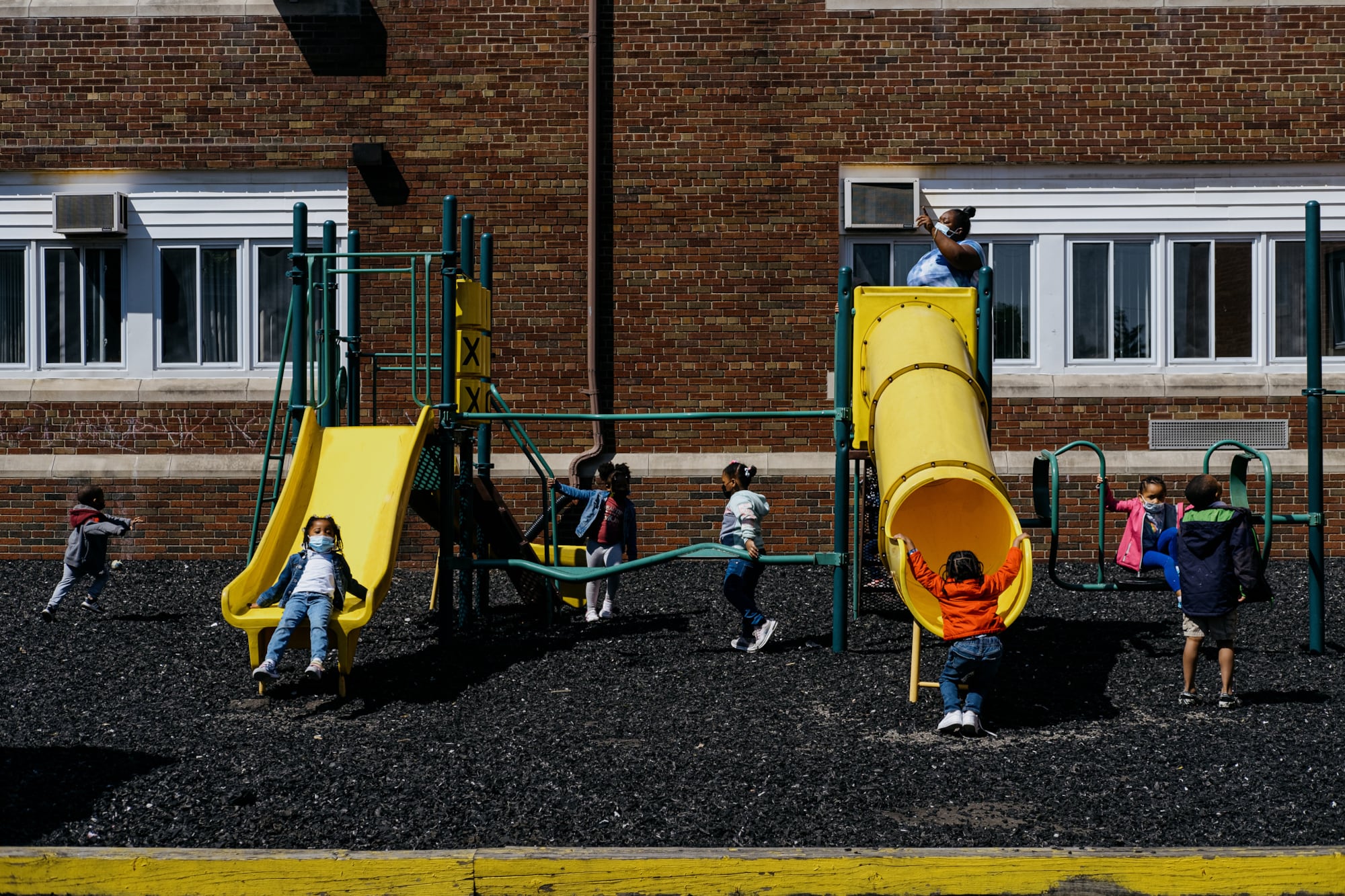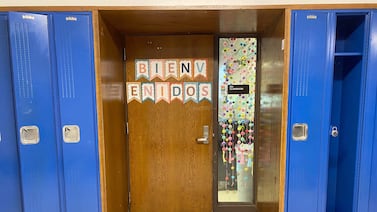Last year, as Gov. Gretchen Whitmer touted the expansion of Michigan’s free preschool program, Beverly Hogan was among the child care providers preparing to open new classrooms.
Now Whitmer has announced an even more ambitious expansion of the Great Start Readiness Program, but Hogan had to close her new classroom in February, laying off two teachers and forcing families to search for another option for their 4-year-olds deep into the school year.
The problem? Hogan couldn’t find enough kids.
Only eight students were enrolled in a classroom designed for 16. At the same time, the state ended a pandemic-era policy of paying providers based on their classroom capacity, even if fewer were enrolled. So Hogan would be paid only for children who were actually enrolled, meaning she would lose half of her funding for the classroom this year, or $74,000.
The expansion is “taking away from our business,” said Hogan, director of Busy Minds Child Care Center in Detroit. “I feel they could have waited” to shift back to enrollment-based funding.
Low enrollment might seem like a counterintuitive challenge for a state that researchers say is in the grips of a full-blown child care crisis. Whitmer built her case for GSRP expansion on the premise that tens of thousands of newly eligible middle-income families would jump at the opportunity to enroll their 4-year-olds in free preschool, and that improvements to the program would entice already-eligible low-income families to join.
Indeed, GSRP enrollment grew statewide this year. And in Wayne County, enrollment rose 17% between 2019 and 2023, from 7,468 to 8,777, according to preliminary data shared by county officials.
But Hogan is not alone in struggling to hit enrollment targets, according to providers and early education experts in the Detroit area, who point to a number of reasons. They speculate that some new classrooms opened in areas where demand for GSRP was already met. At the same time, not enough newly eligible families know about the program. And a significant segment of families simply aren’t ready to join GSRP, because the program runs four days a week and only during the school year, leaving gaps in care.
These may ultimately prove to be manageable hurdles on the path to Whitmer’s ambitious preschool expansion goals. Indeed, Whitmer’s budget proposal includes substantial new funding for GSRP, including dollars specifically for publicity and for programming five days a week.
But for providers, these hurdles come at a substantial cost. The funding reductions are hurting child care centers right now, adding instability to a fragile sector that was already struggling with staff shortages and tight profit margins.
It’s an example of how the GSRP expansion can disrupt the rest of the early childhood ecosystem, a phenomenon advocates have warned about for years. The providers facing financial problems related to GSRP also serve children younger than 4 and offer before- and after-school care.
“This is what we’ve been trying not to do,” said Denise Smith, implementation director for Hope Starts Here, a Detroit-based early childhood initiative.
A Whitmer spokesperson did not return a request for comment.
Change in GSRP funding rules was a turning point
Enrollment fluctuations on their own wouldn’t normally be enough to destabilize child care providers. It’s the change in the funding policy that’s creating short-term problems.
For most of GSRP’s history, centers were paid based on the number of students they enrolled. The switch away from that policy dates to the early part of the COVID pandemic, when early childhood providers became the first educators to resume face-to-face work. Even as their return met the urgent child care needs of essential workers, many more parents opted to keep their children home, so enrollment didn’t come close to recovering to pre-pandemic levels.
To help providers stay open, the Legislature agreed to change its funding method for one year. The state would pay them as if they had 16 students in each classroom, or full capacity under GSRP guidelines.
A year later, recognizing that many centers were still struggling with enrollment, the Michigan Department of Education continued a similar policy for another year.
This year, as the pandemic emergency ebbed, the state opted for a full return to enrollment-based funding. At the same time, county officials were working to expand GSRP programming, asking providers across the state if they could add new classrooms.
The timing meant that providers would face the financial effects of any enrollment fluctuations that resulted from the expansion effort. By adding new classrooms, they were helping meet Whitmer’s goals, but they were also taking on substantial risk.
Hogan and other providers whose enrollment remained below capacity faced a cut in funding and had to consider closing classrooms.
“Everything was fine,” until the state changed the funding method, said Shirley Hailey, executive director of Little Scholars of Detroit. “That’s going to mess us up.”
Hailey closed one of her five GSRP classrooms in February due to low enrollment.
In a statement, MDE spokesperson William Disessa said the funding shift was due to the pandemic, not the GSRP expansion. While the Whitmer administration supported the continuation of the pandemic-era policy last year, the idea of extending it for another year “received no further consideration.”
MDE and Wayne RESA, the county education agency that administers GSRP in Detroit and surrounding communities, say they informed providers of the change at the beginning of the school year and gave regular reminders.
But some providers said they had no idea.
Denise Lomax, owner of Child Star Development Center in Detroit, added a classroom this year, bringing her total to three, but says she wouldn’t have done so if she’d known about the funding change. She has been able to fill only two-thirds of her 48 slots and plans to close one classroom.
“In the beginning, I told them, ‘Maybe I should do two classes because y’all have given this to everyone who wants it,’” she said. “They said … ‘Take the three, we’re going to work with you to make sure we get the children.’”
Where to open new classrooms is a complex question
The governor’s proposed expansion of GSRP beyond current income limits should increase both the supply and demand for preschool statewide. In an ideal world, those two variables would be aligned at the local level, with new GSRP classrooms concentrated in neighborhoods with lots of eligible, unenrolled 4-year-olds.
“What we don’t want to do is open a new program that’s going to compete with existing programs for the same 4-year-olds,” said Dawn Koger, director of early childhood for Oakland Schools, a county education agency north of Detroit. County agencies determine which programs receive GSRP funding.
Achieving that balance is easier said than done, Koger said, because existing GSRP programs are located with low-income communities in mind.
The expansion plans are based largely on increasing the income threshold for the program. A family of four making almost $70,000 can now qualify for the program, and Whitmer wants to push the threshold even higher. Given Michigan’s socioeconomic segregation, newly eligible middle-income families might want programs in different places.
Where to add the new classrooms is a difficult question, especially given a lack of current data on where 4-year-olds live and how much money their parents make.
“It would be wonderful if we had new census data every year,” Koger said.
Officials in Wayne County, which includes Detroit, say they studied the distribution of GSRP-eligible 4-year-olds by ZIP code, but ultimately didn’t factor that data into decisions about the new classroom locations, because it was both imprecise and out of date.
Candies Rogers, director of Circle Time with Friends, a center in Redford, says classrooms in Wayne County opened this year in neighborhoods where demand for GSRP was already met.
“When you put so many child care centers in the same area, it is hard to fill those slots up,” she said. “I believe they opened up too many GSRP classrooms.”
One of her classrooms has only eight students, meaning she too will lose about $74,000 in funding this year. She is keeping it open for the rest of the school year, covering the lost funds out of her center’s bottom line.
Koby Levin is a reporter for Chalkbeat Detroit covering K-12 schools and early childhood education. Contact Koby at klevin@chalkbeat.org.








